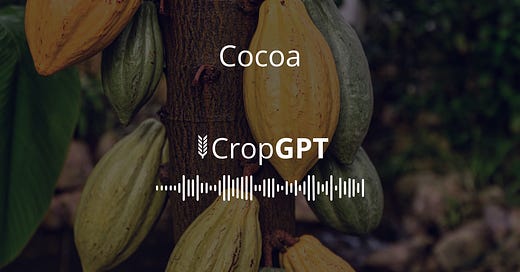Week 26: Cocoa Market Summary
Cocoa supply tightens as West Africa faces yield losses, Nigeria combats scandals, and Ecuador battles floods meanwhile, Brazil’s Pará shines with tech-led productivity gains.
To access the latest cocoa reports, risks and weather -which are updated daily, please use CropGPT
Ivory Coast:
In the Ivory Coast, cocoa producers are facing challenges with mid-crop yield and quality due to cooler-than-average weather patterns hampering growth and slowing export flows. Despite beneficial rainfall, persistently suboptimal temperatures are affecting pod maturation and increasing susceptibility to diseases. Authorities are increasing investments in disease monitoring and climate-resilient agriculture practices. Additionally, the mid-crop cocoa beans are facing a higher rejection rate of up to 6% compared to 1% during the main crop season. The estimated harvest this year is at 400,000 metric tons, indicating a decline of 9% year on year.
Ghana:
Ghana is likely to fall short of its cocoa production targets by 3.3%. COCOBOD is struggling with financial constraints, which hampers its ability to distribute essential farming inputs. Fiscal austerity measures are squeezing agricultural support programs further. Weather anomalies in the Western North and Ashanti regions are disrupting flowering and pod formation, worsening the productivity outlook for the season.
Brazil (Pará):
In Brazil's Pará region, there is a positive outlook with a leading global productivity rate of 847 kg/ha. This success is attributed to effective agroforestry practices, advanced pest control, and digital integration, including real-time crop monitoring technologies. Over half of the cocoa farms in the area are utilizing these technologies to ensure optimal yield and efficient risk management.
Nigeria (Ondo):
In Ondo State, Nigeria, recent cocoa adulteration scandals have posed critical reputational risks, threatening significant export revenues potentially up to $150 million. The state has responded by increasing law enforcement activities, imposing stern penalties, and enhancing inspection procedures to protect the quality and reputation of their cocoa exports. Despite these measures, cocoa exports in April showed a year on year decrease of 11%, reflecting ongoing challenges.
Ecuador:
Ecuador's cocoa situation is mixed due to varied climatic conditions across its growing regions. In Manabí and Esmeraldas, excessive rainfall is leading to minor flooding and increased disease pressure. In contrast, Los Ríos and Guayas are facing severe drought conditions and infrastructure challenges affecting irrigation and crop health. These divergent weather patterns pose distinct challenges for cocoa farmers, complicating the overall production outlook.



